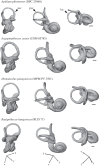Evolution of locomotion in Anthropoidea: the semicircular canal evidence
- PMID: 22696520
- PMCID: PMC3396915
- DOI: 10.1098/rspb.2012.0939
Evolution of locomotion in Anthropoidea: the semicircular canal evidence
Abstract
Our understanding of locomotor evolution in anthropoid primates has been limited to those taxa for which good postcranial fossil material and appropriate modern analogues are available. We report the results of an analysis of semicircular canal size variation in 16 fossil anthropoid species dating from the Late Eocene to the Late Miocene, and use these data to reconstruct evolutionary changes in locomotor adaptations in anthropoid primates over the last 35 Ma. Phylogenetically informed regression analyses of semicircular canal size reveal three important aspects of anthropoid locomotor evolution: (i) the earliest anthropoid primates engaged in relatively slow locomotor behaviours, suggesting that this was the basal anthropoid pattern; (ii) platyrrhines from the Miocene of South America were relatively agile compared with earlier anthropoids; and (iii) while the last common ancestor of cercopithecoids and hominoids likely was relatively slow like earlier stem catarrhines, the results suggest that the basal crown catarrhine may have been a relatively agile animal. The latter scenario would indicate that hominoids of the later Miocene secondarily derived their relatively slow locomotor repertoires.
Figures



Similar articles
-
Anthropoid origins.Science. 1997 Feb 7;275(5301):797-804. doi: 10.1126/science.275.5301.797. Science. 1997. PMID: 9012340 Review.
-
Semicircular canal system in early primates.J Hum Evol. 2009 Mar;56(3):315-27. doi: 10.1016/j.jhevol.2008.10.007. Epub 2009 Jan 30. J Hum Evol. 2009. PMID: 19185902
-
Astragalar morphology of late Eocene anthropoids from the Fayum Depression (Egypt) and the origin of catarrhine primates.J Hum Evol. 2001 Dec;41(6):577-606. doi: 10.1006/jhev.2001.0508. J Hum Evol. 2001. PMID: 11782110
-
Comparative anatomy of the carotid canal in the Miocene small-bodied catarrhine Pliobates cataloniae.J Hum Evol. 2021 Dec;161:103073. doi: 10.1016/j.jhevol.2021.103073. Epub 2021 Oct 7. J Hum Evol. 2021. PMID: 34628300
-
Functional morphological similarities in the locomotor skeleton of miocene catarrhines and platyrrhine monkeys.Folia Primatol (Basel). 1996;66(1-4):7-14. doi: 10.1159/000157180. Folia Primatol (Basel). 1996. PMID: 8953745 Review.
Cited by
-
Wrist morphology reveals substantial locomotor diversity among early catarrhines: an analysis of capitates from the early Miocene of Tinderet (Kenya).Sci Rep. 2019 Mar 6;9(1):3728. doi: 10.1038/s41598-019-39800-3. Sci Rep. 2019. PMID: 30842461 Free PMC article.
-
Bony labyrinth shape variation in extant Carnivora: a case study of Musteloidea.J Anat. 2016 Mar;228(3):366-83. doi: 10.1111/joa.12421. Epub 2015 Nov 18. J Anat. 2016. PMID: 26577069 Free PMC article.
-
New data about semicircular canal morphology and locomotion in modern hominoids.J Anat. 2017 Jul;231(1):95-109. doi: 10.1111/joa.12619. Epub 2017 May 19. J Anat. 2017. PMID: 28523740 Free PMC article.
-
Sensory Reconstruction of the Fossil Lorisid Mioeuoticus: Systematic and Evolutionary Implications.Animals (Basel). 2025 Jan 25;15(3):345. doi: 10.3390/ani15030345. Animals (Basel). 2025. PMID: 39943115 Free PMC article.
-
The vertebrate middle and inner ear: A short overview.J Morphol. 2019 Aug;280(8):1098-1105. doi: 10.1002/jmor.20880. Epub 2018 Aug 17. J Morphol. 2019. PMID: 30117612 Free PMC article. Review.
References
-
- Silcox M. T., Bloch J. I., Boyer D. M., Godinot M., Ryan T. M., Spoor F., Walker A. 2009. The semicircular canal system in early primates and euprimates. J. Hum. Evol. 56, 315–327 10.1016/j.jhevol.2008.10.007 (doi:10.1016/j.jhevol.2008.10.007) - DOI - DOI - PubMed
-
- Spoor F., Garland T., Krovitz G., Ryan T. M., Silcox M. T., Walker A. 2007. The primate semicircular canal system and locomotion. Proc. Natl Acad. Sci. USA 104, 10 808–10 812 10.1073/pnas.0704250104 (doi:10.1073/pnas.0704250104) - DOI - DOI - PMC - PubMed
-
- Walker A., Ryan T. M., Silcox M. T., Simons E., Spoor F. 2008. The semicircular canal system and locomotion: the case of extinct lemuroids and lorisoids. Evol. Anthropol. 17, 135–145 10.1002/evan.20165 (doi:10.1002/evan.20165) - DOI - DOI
-
- Spoor F., Zonneveld F. 1998. Comparative review of the human bony labyrinth. Yearb. Phys. Anthropol. 41, 211–251 10.1002/(SICI)1096-8644(1998)107:27+<211::AID-AJPA8>3.0.CO;2-V (doi:10.1002/(SICI)1096-8644(1998)107:27+<211::AID-AJPA8>3.0.CO;2-V) - DOI - DOI - PubMed
-
- Leigh R. J., Brandt T. 1993. A reevaluation of the vestibulo-ocular reflex: new ideas of its purpose, properties, neural substrate, and disorders. Neurology 43, 1288–1295 10.1212/WNL.43.7.1288 (doi:10.1212/WNL.43.7.1288) - DOI - DOI - PubMed
Publication types
MeSH terms
LinkOut - more resources
Full Text Sources

